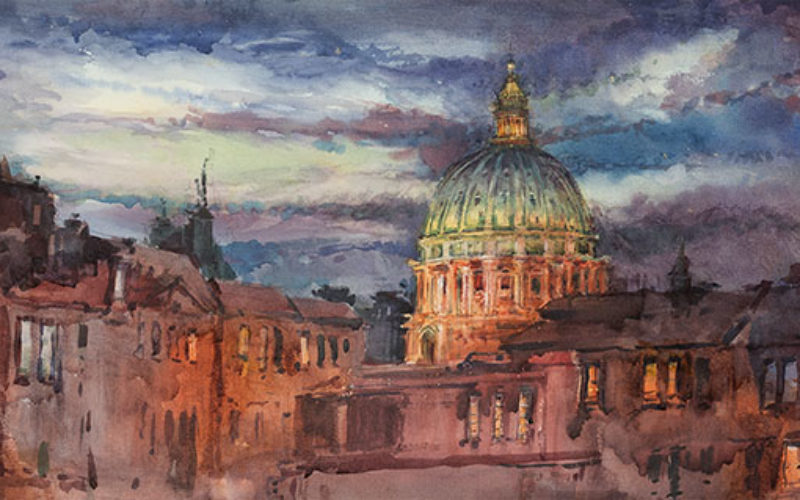Master of watercolor Tim Clark featured at FSRAM
BECCA MARTIN-BROWN
bmartin@nwadg.com
Back in the days when Lou Meluso was a budding artist — and not the executive director of the Fort Smith Regional Art Museum — watercolor ran neck and neck with photography as his medium of choice. One of his inspirations was a watercolorist named Timothy J. Clark, whose book “Focus on Watercolor” was one of his bibles.
“I was very excited about the fluidity of the medium, the spontaneity the medium offered, and the fact that it wasn’t as controllable [as other media],” Meluso remembers. “I tended to overwork things, and watercolor allowed me to become bolder and much looser. I loved the way the colors blended, the way you can use simple color combinations of warm and cool to excite the eye. Those were the things that got me interested in watercolor. I transitioned from being a very tight watercolor painting to a much looser, freer style — and Tim was a big part of that.”
The two men became friends earlier this year, when FSRAM hosted “Forms and Figures,” an exhibit of works by Will Barnet.

Courtesy Images
“Woven through Timothy J. Clark’s paintings are unique combinations of visual and emotional stimuli,” writes Will Barnet, whom Clark considers a mentor. “His sense of space, light and composition combine to create graphic tensions which intrigue beyond the beautifully painted forms of the subjects.”
“Will was sort of a mentor to Tim,” Meluso explains. “Tim came and gave a wonderful, well-attended lecture, and while he was here, I just brought up the concept of having a show here. Tim is pretty well known in the Fort Smith/Van Buren area: He and Jane Owen at the Center for Art and Education in Van Buren have been good friends for many years, and Tim has a lot of fans in the area. A lot of the pieces we’re putting up here are on loan from local collectors.”
Melusa explains that watercolor has a long tradition as an essential part of an artist’s education and was the medium of choice for some of the great American painters, among them John Singer Sargent.
Born in 1951 and raised in Santa Ana, Calif., Clark started his career in oil paints, but “sensitivity to the solvents in oil pigments forced him to switch to watercolor,” writes Janet Blake, curator of Early California Art at the Laguna Art Museum. “This was a serendipitous event because it was with watercolor that Clark would find his true calling as an artist and as a teacher.
“Watercolor is recognized as a most demanding technique, one requiring an acute eye for color, light and form, and a sure hand with the brush, every stroke carefully considered,” she continues. “At the same time, however, it is perhaps the most expressive technique.”
“Clark’s ostensibly forthright watercolors … not only are glittering in their execution — bathed in sunlight, swathed in shadow, shimmering with sure-handed yet expansive and textured brushwork … but also embody the postmodern concept of art-as-idea,” adds art historian Lisa Farrington. “These are no ‘pretty pictures,’ but diffidently profound documents of human existence.”
“As far as I’m concerned, the watercolors in this show are about inspiration and expression,” Meluso says enthusiastically. “He certainly has a special talent – a great eye for the subject, such an easy way with handling the media. You look and can just be amazed at the way he can blend colors, whether it be a quick study, a quick impression, or a more evolved painting. His way of handling the media is so loose and masterful. … When you see some of these delicate interiors and portraits he’s painted, so skillfully done, it reminds me a lot of Winslow Homer and his subtle handling of light and shadow. It’s going to be a wonderful treat for fans and people new to his work alike.
“There is nothing you need to know,” he answers the concerns of inexperienced art patrons. “The visual appeal is so strong in these paintings, not just the watercolor medium, but Tim has an ability to infuse life into his subjects. You really get a sense of realism within a very loose technique. It doesn’t need any deep interpretation, just the wonder of how he connects with the subject and can transform it into this spontaneous style.”
__
FAQ
Timothy J. Clark:
Masterworks On Paper
WHEN — Dec. 7-March 31
WHERE — Fort Smith Regional Art Museum
COST — Free
INFO — 784-2787; fsram.org
BONUS — A reception from 5 to 7 p.m. Dec. 6 will welcome Clark. Admission is $10 for nonmembers.



